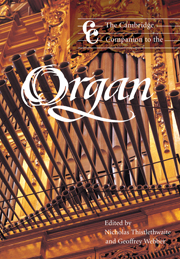8 - A survey of historical performance practices
from Part II - The player
Published online by Cambridge University Press: 28 September 2011
Summary
In my opinion, there are faults in our way of writing music, which correspond to the way in which we write our language. That is, we write things differently from the way in which we execute them; which means that foreigners play our music less well than we play theirs.
(François Couperin 1717: 39)The notation of music is at best an approximation of the timbre, quality and placement of sounds in time. Musicians universally rely upon aural traditions to fill in notational gaps, and this is especially true in keyboard training, which usually takes place in individual lessons where the teacher instructs the pupil through verbal descriptions and practical demonstrations. Traditions of interpretation are passed from generation to generation through this personal contact where ambiguities arising from the descriptions can be clarified by the demonstrations. Over time, changing musical aesthetics are reflected in changing approaches to interpretation, so that the performance traditions for earlier musics are gradually transformed. This is especially true for the organ's vast repertoire, which spans a wide chronological and geographical spectrum with many variations in musical style and organ building. To perform this music convincingly today, it may be helpful to assess relevant information preserved in historical organs, treatises on keyboard technique, and sources of music. This chapter presents a selective historical overview of fingering, ornamentation and rhythmic alteration as practised in the performance of organ music until the time of Bach.
Sixteenth-century German sources
The first written sources to describe aspects of organ-playing technique date from the sixteenth century, when instrumental music was developing independently of vocal forms and printing enabled experts to disseminate their teaching through practical tutors. The earliest of these for organists was published in Mainz in 1511 by Arnolt Schlick. Entitled Spiegel der Orgelmacher und Organisten, the treatise deals with such pragmatic issues as constructing a smooth responsive action and voicing pipes well. His infrequent remarks on performance concern the organist’s position at the instrument [113] and provide guidelines on registration.
- Type
- Chapter
- Information
- The Cambridge Companion to the Organ , pp. 113 - 129Publisher: Cambridge University PressPrint publication year: 1999



